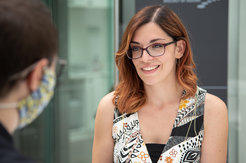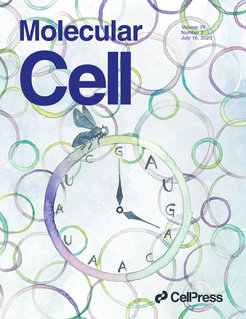When corona leads to cover art
An interview with Druna Di Giacomo by Kai Fiedler
Have you ever thought about where scientific journals get their cover art from? Some cover art comes from the pen of PhD students looking for a way to channel their creativity; perhaps even more so during the work situation caused by the Corona pandemia- as the following example shows.

Bruna Di Giacomo is a second year PhD student in the laboratory of Linda Partridge at the Max Planck Institute for Biology of Ageing. During her PhD studies she aims to describe the role of the transcription factor FOXO in ageing and metabolism of the fruit fly Drosophila melanogaster. When her colleague Carina Weigelt published a study about the influence of the circular RNA circSfl on lifespan in the scientific journal Molecular Cell, Bruna was asked to design a possible art work for the journal’s cover page.
“I have always been interested in doing arts and crafts. Before starting my PhD modelling and sculpturing were extensive hobbies of mine. During the Corona measures I rediscovered doing arts as a way to fight boredom and express myself while doing something meaningful. I used water colours to paint pictures and paintings that I uploaded on my Instagram page. Carina saw my pictures and asked me if I would like to paint a cover art representing her publication in Molecular Cell.”

For one week Bruna and Carina discussed different ideas, structures and possible colours. The most important thing for both of them was to use a simple idea to convey the scientific message.
“We decided for several circles representing circular RNAs. The largest circle in the foreground stands for circSfl, the circular RNA about which the study deals. To symbolize the influence on lifespan and ageing the circle is designed as a clock, but instead of the digits, the letters of the RNA sequence of circSfl are on the dial.” In addition, a fruit fly lying on the edge of the clock was added to the artwork to represent the model organism, in which circSfl was studied.
When sending the final version to the journal one never knows if the painting is chosen for the cover or whether all the effort has been in vain. The joy was all the greater when the artwork was selected.

“It was so much fun to do this project during the Corona period and I was even more excited when my artwork was selected for the cover page.
Carina sent me the message on the phone when I visited my family in Italy. I was particularly pleased with the nice reactions of my colleagues and my boss Linda.”
For Bruna this was the first publication of one of her artworks, but most likely not the last one: “The PhD is mostly about doing science. But it’s also important to think about how to convey your message to the scientific audience or even to the broader public. Combining science and art is a wonderful and fun way to communicate your science. I now could even imagine working as a science illustrator as having so much fun creating this cover art.”














